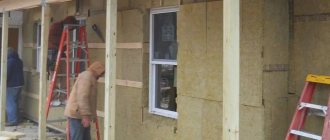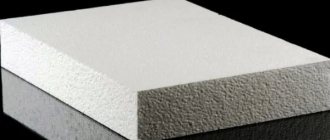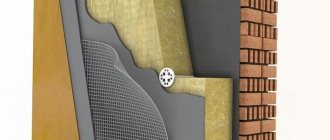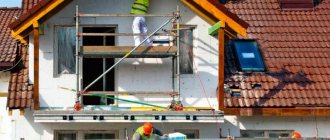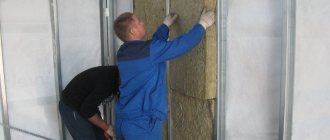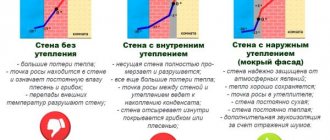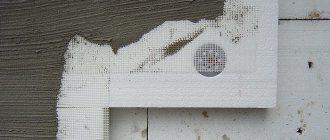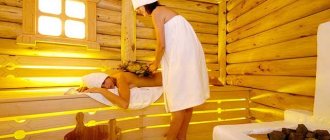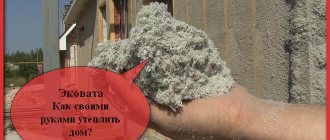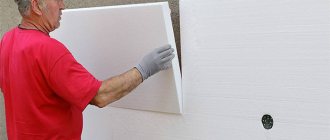Any home renovation work must be carried out with extreme care. It is worth carefully choosing materials for construction and monitoring the quality of the work performed. The final result will directly depend on these factors. Currently, many brick houses are in unsatisfactory condition, which brings inconvenience to their residents. It is often necessary to replace window units, as well as to carry out work on home insulation. Facade work can be difficult, but insulating the walls of a house inside under drywall can be done independently. The method is effective and anyone can handle it.
A situation often arises when walls require not only insulation, but also a change in geometry, simply put, alignment. An excellent universal solution can be the use of plasterboard sheets. They themselves are initially an excellent sound absorber and heat insulator. If the installation is carried out using a frame method, then there remains free space between the drywall and the wall surface, into which an additional insulating layer can be placed. This method very effectively retains heat in a living space and does not require hired force, since it is quite simple to implement. All that is required is to make calculations on the amount of consumables and study the insulation technology.
The plasterboard slab is attached to the wall in one of the following ways:
- Adhesive - direct installation is only suitable for walls with minor defects.
- Frame - recommended by experts. The metal base can retain its shape for many years and better retains heat indoors.
Not only the heating system, but also the thermal insulation properties of the materials that were used in the construction and finishing of the wall surfaces are responsible for maintaining a favorable temperature regime in the home. The low thermal conductivity coefficient helps maintain a comfortable temperature in the room. If there are gaps in the windows and walls, they will release warm air from the room during the cold period and the owners will be faced with the question of insulating the walls in order to trap warm air inside the living space.
Expert opinion
Konstantin Alexandrovich
The thermal conductivity index of gypsum plasterboard is 10 times lower than the same parameter usually used in the construction of a concrete slab and amounts to 0.15. Based on this, a sheet of drywall, even on its own, will be a good way to conserve heat. If you install insulation under a layer of drywall, the thermal insulation properties of the walls will significantly improve. For these purposes, a frame is mounted, creating an additional layer of air.
Technical features of gypsum boards
GCR itself is not an insulation material. Construction and finishing sheets have a thermal conductivity that is 10 times lower than that of reinforced concrete slabs and bricks, and 10 times higher than that of mineral wool. A piece screwed to the wall feels much warmer to the touch than conventional partitions. At low temperatures and no heating in the room, the surface is perceived as cold.
Insulation under sheets Source akvilon.ua
In order for gypsum board to insulate, it must be laid out in a thick layer of 20-30 cm. Such a structure will steal 40-60 cm of usable space from the room. The cost of purchasing sheet raw materials will be much higher than using mineral wool or polystyrene foam. Construction and finishing materials are best used in combination with heat insulators.
Insulation of walls under plasterboard is carried out using two technologies. Most often it is recommended to give preference to the frame method. In the room, a sheathing is assembled from a metal profile or wooden blocks, onto which the plasterboard is attached. The space between the partition and the wall is filled with a special heat-insulating material.
The frame method ensures the most effective insulation of the room and ease of installation. A correctly assembled “pie” will not only make the room warm, but also protect it from external noise. The technology has 3 disadvantages:
- Hiding the area. The lathing takes at least 10 cm from each wall, which is problematic for tiny rooms.
- Low mechanical strength. The structure does not withstand impacts well.
- Hanging heavy objects is prohibited. To neutralize the problem, additional guides have to be added to the sheathing.
In compact spaces, professionals use frameless technology. Plasterboard with insulation fixed directly to the wall can achieve a good thermal insulation effect. The materials are connected with a special adhesive and self-tapping screws. The partitions must be smooth and strong, otherwise installation difficulties will arise. It will not be possible to create a thick layer of thermal insulation.
Insulation without lathing Source wikipotolok.com
When is it necessary to insulate indoor walls?
The most effective option for wall insulation is installing thermal insulation on the outside of the façade.
But only owners of private houses can afford this. This method is also expensive. In apartment buildings, if they are not insulated from the outside with thermal insulation materials, residents have only one choice for insulating the walls themselves - internal thermal insulation. Private homeowners also often choose this option as an economical one.
They prefer to use plasterboard for wall cladding because it has a number of advantages over other finishing materials:
- lightweight and easy to handle;
- has thermal insulation properties;
- allows you to quickly create perfectly smooth surfaces;
- under such a coating you can place any type of insulation, even soft ones;
- its cost is not high.
Installation algorithm
Thermal insulation of internal partitions using gypsum plasterboard does not require high qualifications from the performer. For the work, standard skills and universal equipment that you have at home are sufficient. Let's look at the algorithm of actions in detail.
Preparation
At the first stage, the walls are cleaned of dirt and dust. We recommend filling large cracks and unevenness in partitions with putty. Protruding fasteners and remnants of reinforcement must be removed. The surface is treated with an antibacterial solution and dried thoroughly.
Frame assembly
It is more convenient to do marking work with a laser rangefinder, although a regular plumb line will do. The sheathing is assembled from a metal profile or wooden blocks. Before the procedure, natural material is coated with antifungal impregnation, otherwise it will rot over time.
The starting strip is glued to the floor with tape. Vertical guides are screwed to the profile with self-tapping screws and to the wall with dowels. The ends of the parts are fixed with fleas. There should be 4 slats for each gypsum board sheet.
The finished structure is stable. Cross bars improve the rigidity of the frame. The length of the products overlaps adjacent guides by 50%. The blanks are fixed to the surface of the sheathing with fasteners.
How long will the insulation last?
The service life of insulation depends on its type.
Cheap materials are on average suitable for use for 20-30 years. Some expensive brands have a service life of up to 50 years in their technical specifications (but this is not always tested in practice). Over time, the substance ages, the structure of the material is destroyed, it dries out or cakes, and loses more than 1/3 of its thermal insulation properties. Most types of insulation are recommended to be replaced at least every 35 years.
To create a healthy, favorable microclimate in the house, you can independently carry out the work of insulating the internal walls. For this purpose, lightweight, easy-to-install materials are used. With their help, you can make high-quality wall repairs with your own hands, even without professional training, using tools available in everyday life.
Video description
How to assemble a plasterboard partition with insulation with your own hands.
Insulation
The vapor barrier membrane is installed first. Thermal insulating material is inserted into the free space (“windows”) of the frame. Mineral or glass wool is attached using special foam, which is applied around the perimeter and in the center of the mat. For reliability, the raw materials are screwed with self-tapping screws.
After installing the vapor barrier, foam and polystyrene foam are mounted with glue. The slabs, prepared to size and treated with the composition, are fixed to the wall. All joints are taped with construction tape. The holes between the material and the ceiling are sealed with silicone-based sealant.
When installing isolon, a membrane is not needed. The raw materials are cut into pieces before the procedure. The sheet is placed with the foil side in the room. The vapor barrier is glued with the rough part facing inward.
Installation of mineral wool Source zen.yandex.com
Installation of gypsum board sheets
If working with drywall is new to you, you need to first familiarize yourself with some of its features. Before installing the guide profiles, a special tape is laid along the intended installation lines. It will serve as protection against contact with plaster. In this case, the drywall will be protected from the cold that comes from the metal profile.
Metal profiles are usually installed at a distance of 2 cm from the wall. It is recommended to install a frame made of galvanized profile. After installing the frame, insulation boards are placed behind it. The material must be inserted vertically. In no case should the edges of the insulation protrude beyond the front side of the profile.
How to insulate walls from the inside with mineral wool plus plasterboard
A comfortable indoor environment largely depends on the temperature, to maintain which certain resources and funds are spent. If the material or thickness of the external walls is incorrectly chosen, the cost of heating the house may be too high, and in addition, there is a danger of the walls collapsing. The threat is quite serious, and signs of undesirable processes become noticeable already at an advanced stage. The solution to the issue is wall insulation, which should be considered in more detail.
Which basalt wool is better to choose?
The effectiveness of wall insulation with basalt depends on the correctly selected insulation and compliance with insulation technology. Among the criteria by which it is necessary to choose insulation: the thickness and density of the mats, as well as the manufacturer.
Thickness. The thickness of stone wool for wall insulation depends on the climatic zone in which the house (the apartment is located) is built and on the type of walls: concrete, brick, wood or frame.
For central Russia, an indoor insulating layer of basalt 50 mm thick copes with its function perfectly. For a facade, a thickness of 100 mm is needed, for a frame house - 150-200 mm.
If you wish, you can use an online calculator to more accurately calculate the thickness of the insulation.
Density. The thermal conductivity of the material (the lowest for insulation with a density of 60-80 kg/m3) and the rigidity of the slabs depend on the density indicator. The rigidity indicator is very important when insulating a frame house, where a lot of pressure is applied to the bottom row and when finishing work is carried out directly on the insulation (decorative plaster).
The density of basalt wool for wall insulation should be within:
- 50-75 kg/m3 for frame houses;
- 80-130 kg/m3 for walls with a gap for ventilation;
- 130-160 kg/m3 with the “wet” method of insulation;
- 150-175 kg/m3 for a concrete facade.
It is better to buy basalt fiber wool from reputable manufacturers on the market. At the same time, it is not necessary to strive to purchase mats with the brand “PAROC” or “Rockwool”. They have high quality, but the price is also very high.
Other manufacturers' quality fully complies with European and Russian standards, and the cost is an order of magnitude lower. Therefore, why overpay for a trademark if there are products from TechnoNikol, Isover, URSA, and Beltep (Belarus).
Popular thermal insulators for interior work
Nowadays, internal insulation of brick walls can be carried out using different methods, which is why it is so important to correctly choose the most suitable material for these purposes, taking into account the characteristics of the given structure. The material is selected taking into account its fire resistance, thermal conductivity and density
These indicators affect the weight of the material and the thickness of the insulation. And the service life largely depends on the strength of the material.
The material is selected taking into account its fire resistance, thermal conductivity and density. These indicators affect the weight of the material and the thickness of the insulation. And the duration of operation largely depends on the strength of the material.
The most popular insulation materials include:
- Expanded clay. This insulation is added to the base, after which a monolithic frame is formed from it;
- Mineral wool. This insulation has good moisture absorption, so it allows you to insulate the house from the inside. Glass wool, which is also used as insulation, is one of the varieties of mineral wool;
- Warm plaster. This material is a universal insulation material because it can be used both inside the house and for facade work. The insulation retains heat well, but it is a heavy material, so it is used only in houses with a reinforced foundation;
- Cellulose wool. This material retains heat well, has excellent absorbency, but is subject to mechanical stress; experts recommend this insulation for interior work;
- Cork insulation. The positive characteristics of the material include its ability to retain heat well, however, it is flammable;
- Styrofoam. The reasonable price and the ability to use this material for both interior and facade work have made it popular. However, this insulation has disadvantages: it does not “breathe” and releases harmful compounds during the ignition process.
Less popular insulation materials are: extruded polystyrene foam, penofol, penoplex, polyurethane foam and penoizol.
Criteria for choosing material, requirements for insulation, which is better
When choosing insulation of walls inside a brick house, first of all, it is necessary to take into account the thermal insulation properties of the material. In addition, the most significant characteristic of the material is vapor permeability.
The following actions will help prevent contact of freezing brick wall surfaces with steam:
- Wall cladding with a polymer heat insulator such as extruded polystyrene foam, sprayed polyurethane foam, high-density foam or penofol.
- Use of mineral wool insulation material.
- Applying a thick layer of heat-insulating plaster.
When planning to insulate your home, you should also consider the method of installing the heat insulator.
When choosing insulation of walls inside a brick house, first of all, it is necessary to take into account the thermal insulation properties of the material.
Types of drywall and its use
Drywall can be used to insulate walls inside a building. Use either moisture resistant or wall.
Moisture-resistant can be used in dachas or for rooms with a high degree of humidity: bathrooms and kitchens.
Important! Moisture-resistant plasterboard, the best solution for rooms where heating is not provided.
This material is not at risk of cyclical temperature fluctuations. After installing the sheets, you only need to apply a waterproof primer or protective paint to the front part. You should also treat drywall with an antiseptic to kill harmful germs and bacteria.
